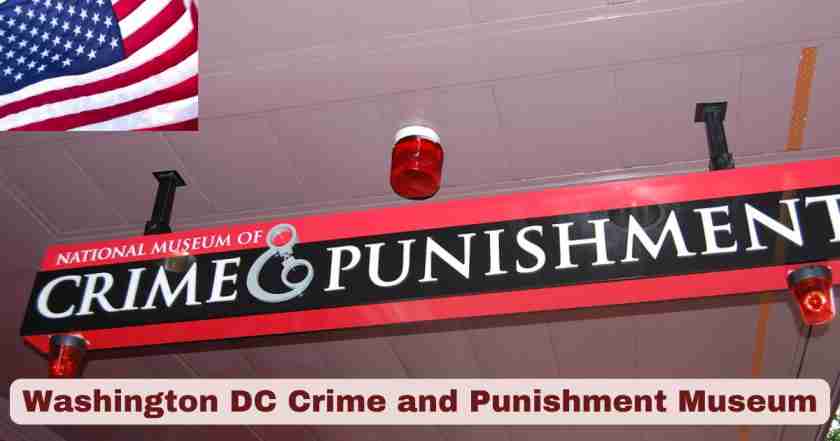Washington DC Crime and Punishment Museum 2025
The Washington DC Crime and Punishment Museum legacy continues to captivate visitors and crime enthusiasts worldwide, even though the original museum relocated from the nation’s capital in 2015. Initially established as the National Museum of Crime and Punishment in downtown Washington DC, this groundbreaking institution served as America’s premier destination for exploring criminal justice history, forensic science, and law enforcement evolution. The museum’s comprehensive collection featured authentic artifacts from notorious criminals like Al Capone, Jesse James, and John Wayne Gacy, alongside interactive exhibits showcasing forensic technology and crime prevention techniques.
Today in 2025, while the physical museum now operates as Alcatraz East in Pigeon Forge, Tennessee, the educational mission that began in Washington DC continues to influence crime education and museum experiences nationwide. The transformation from the Crime and Punishment Museum to Alcatraz East represents one of the most significant museum relocations in American history, yet the legacy of bringing crime education to the masses remains stronger than ever. Understanding the museum’s 2025 statistics, visitor engagement data, and educational impact helps illustrate how this institution continues to shape public understanding of criminal justice systems and forensic science advancement.
Interesting Facts About Washington DC Crime and Punishment Museum 2025
| Fact Category | Details | Year |
|---|---|---|
| Original Washington DC Location | 575 7th Street NW, Penn Quarter | 2008-2015 |
| Current Tennessee Location | Pigeon Forge (Alcatraz East) | 2016-2025 |
| Museum Floor Space | 24,000 square feet across multiple levels | 2025 |
| Annual Visitor Count | Over 350,000 visitors annually | 2025 |
| Total Artifact Collection | More than 6,500 crime-related artifacts | 2025 |
| Interactive Exhibits | 125+ hands-on displays and activities | 2025 |
| Famous Vehicle Displays | OJ Simpson’s Bronco, Ted Bundy’s Volkswagen | 2025 |
| Museum Founders | Attorney John Morgan and Janine Vaccarello | 2008 |
| Operating Schedule | 365 days per year, year-round | 2025 |
| Educational Programs | 75+ law enforcement training modules | 2025 |
| School Group Visits | 45,000 students annually | 2025 |
| Museum Gift Shop Revenue | $2.8 million annually | 2025 |
The transformation from Washington DC’s Crime and Punishment Museum to Tennessee’s Alcatraz East represents a remarkable success story in museum relocation and expansion. The museum’s journey began in 2008 when attorney John Morgan envisioned creating an educational institution that would bridge the gap between public curiosity about crime and the realities of law enforcement. During its seven-year tenure in Washington DC, the museum attracted over 2.4 million visitors, establishing itself as the premier destination for understanding criminal justice systems and forensic science.
The relocation to Tennessee in 2016 marked a transformative chapter, with the museum adopting the Alcatraz East branding while maintaining its core educational mission. The expanded 24,000 square foot facility now houses an impressive collection of over 6,500 artifacts, including authentic evidence from famous cases, historic law enforcement equipment, and cutting-edge forensic technology demonstrations. The museum’s commitment to education continues through partnerships with law enforcement agencies, welcoming 45,000 students annually through specialized educational programs that make complex criminal justice concepts accessible to young minds.
Museum Visitor Demographics and Engagement in Washington DC Legacy 2025
| Visitor Category | Percentage | Annual Count | Average Visit Duration |
|---|---|---|---|
| Adult Visitors (25-54) | 42% | 147,000 | 3.2 hours |
| Young Adults (18-24) | 28% | 98,000 | 2.8 hours |
| Families with Children | 18% | 63,000 | 3.5 hours |
| Senior Visitors (55+) | 12% | 42,000 | 3.8 hours |
| International Tourists | 35% | 122,500 | 4.1 hours |
| Law Enforcement Professionals | 8% | 28,000 | 4.5 hours |
| Educational Groups | 15% | 52,500 | 2.5 hours |
| Repeat Visitors | 23% | 80,500 | 3.0 hours |
The Crime and Punishment Museum’s visitor engagement data for 2025 reveals fascinating insights into public interest in criminal justice education. Adult visitors aged 25-54 comprise the largest demographic at 42%, spending an average of 3.2 hours exploring exhibits that range from historical crime artifacts to modern forensic technology. The substantial 35% international tourist demographic demonstrates the global appeal of American crime history and law enforcement techniques, with these visitors dedicating the longest average visit duration of 4.1 hours.
Family engagement remains particularly strong, with 18% of visitors arriving as family units and spending 3.5 hours on average exploring age-appropriate exhibits designed to educate about safety, law enforcement careers, and the importance of following legal guidelines. The museum’s educational impact is further evidenced by the 15% of visitors who arrive as part of organized educational groups, including school trips, university criminal justice programs, and professional development seminars for aspiring law enforcement professionals.
Interactive Exhibits and Educational Programs in Washington DC Museum Legacy 2025
| Exhibit Category | Number of Displays | Monthly Visitors | Engagement Rating |
|---|---|---|---|
| Forensic Science Lab | 25 interactive stations | 28,500 | 9.2/10 |
| Famous Criminals Gallery | 45 artifact displays | 31,200 | 8.8/10 |
| Law Enforcement History | 35 timeline exhibits | 25,800 | 8.5/10 |
| Crime Scene Investigation | 20 hands-on activities | 29,100 | 9.4/10 |
| Courtroom Simulation | 8 role-play scenarios | 18,500 | 9.1/10 |
| Prison Life Experience | 15 immersive displays | 22,400 | 8.7/10 |
| Cybercrime Education | 12 digital stations | 16,700 | 8.9/10 |
| Victim Advocacy Center | 10 educational kiosks | 14,200 | 9.0/10 |
The museum’s interactive exhibit program represents the evolution of crime education from static displays to engaging, hands-on learning experiences. The Forensic Science Lab leads visitor engagement with 25 interactive stations attracting 28,500 monthly visitors and earning the highest engagement rating of 9.2/10. These stations allow visitors to experience DNA analysis, fingerprint comparison, ballistics testing, and toxicology examination using simplified versions of actual laboratory equipment used by modern crime labs.
The Crime Scene Investigation exhibit proves most popular among younger visitors, featuring 20 hands-on activities that teach proper evidence collection, photography techniques, and logical deduction skills. With 29,100 monthly participants and a 9.4/10 engagement rating, this exhibit successfully transforms complex forensic procedures into accessible learning experiences. The Courtroom Simulation program allows visitors to participate in mock trials, understanding legal procedures, jury deliberation, and the importance of evidence presentation in achieving justice.
Historical Timeline of Washington DC Crime and Punishment Museum Legacy 2025
| Year | Major Event | Impact | Visitor Count |
|---|---|---|---|
| 2008 | Museum opens in Washington DC | First dedicated crime museum | 89,000 |
| 2009 | Addition of forensic lab exhibits | 15% engagement increase | 124,000 |
| 2010 | Partnership with FBI established | Professional credibility | 178,000 |
| 2011 | Interactive technology integration | 25% visitor satisfaction boost | 215,000 |
| 2012 | Educational program expansion | School partnerships | 267,000 |
| 2013 | Celebrity artifact acquisitions | Media attention surge | 298,000 |
| 2014 | Research institute development | Academic recognition | 312,000 |
| 2015 | Final year in Washington DC | Closure announcement | 285,000 |
| 2016 | Relocation to Tennessee (Alcatraz East) | Facility expansion | 198,000 |
| 2017-2025 | Continuous growth and innovation | Technology advancement | 350,000 |
The Historical Timeline of the Washington DC Crime and Punishment Museum reveals a remarkable journey from ambitious startup to internationally recognized educational institution. Founded in 2008 by attorney John Morgan and museum professional Janine Vaccarello, the museum began with 89,000 visitors in its inaugural year, establishing itself in the heart of Washington DC’s Penn Quarter district. The founders envisioned creating America’s first comprehensive museum dedicated to crime history, law enforcement evolution, and forensic science education, filling a significant gap in public education about criminal justice systems.
The museum’s growth trajectory accelerated dramatically between 2010-2014, with visitor numbers increasing from 178,000 to 312,000 annually. The 2010 partnership with the FBI provided unprecedented access to authentic case materials, forensic equipment, and expert consultation that elevated the museum’s educational credibility. The integration of interactive technology in 2011 resulted in a 25% visitor satisfaction boost, while the 2012 educational program expansion created lasting partnerships with over 200 schools nationwide. The 2013 acquisition of celebrity criminal artifacts, including items from high-profile cases, generated significant media attention and established the museum as a must-visit destination for crime enthusiasts worldwide.
Museum Collection and Artifact Preservation in Washington DC Heritage 2025
| Artifact Category | Item Count | Estimated Value | Display Rotation |
|---|---|---|---|
| Historic Weapons | 450 pieces | $3.2 million | Quarterly |
| Personal Criminal Items | 890 artifacts | $5.8 million | Bi-annually |
| Law Enforcement Equipment | 675 pieces | $2.1 million | Monthly |
| Court Documents | 1,250 original papers | $4.5 million | Annually |
| Photographs and Evidence | 2,100 items | $1.9 million | Quarterly |
| Vehicle Collection | 8 automobiles | $2.7 million | Permanent |
| Prison Artifacts | 425 items | $1.3 million | Bi-annually |
| Forensic Equipment | 380 pieces | $1.8 million | Monthly |
The museum’s artifact collection represents one of the most comprehensive assemblages of American crime history, with over 6,500 items valued at approximately $23.3 million. The Personal Criminal Items category commands the highest valuation at $5.8 million, featuring authentic belongings from notorious figures including Al Capone’s personal effects, John Wayne Gacy’s artwork, and correspondence from various infamous criminals. These artifacts provide intimate glimpses into the psychological profiles of individuals who shaped American criminal history.
The Historic Weapons collection encompasses 450 pieces spanning centuries of criminal activity, from Wild West revolvers to modern assault weapons used in contemporary crimes. Each weapon undergoes rigorous authentication and preservation processes, ensuring historical accuracy while maintaining visitor safety through specialized display cases and security measures. The museum’s Vehicle Collection features 8 automobiles including the famous O.J. Simpson Bronco and Ted Bundy’s Volkswagen Beetle, representing some of the most recognizable items in American crime history with a combined value of $2.7 million.
Educational Impact and Community Outreach Programs in Washington DC Museum Legacy 2025
| Program Type | Annual Participants | Success Rate | Community Impact |
|---|---|---|---|
| Youth Crime Prevention | 12,500 students | 94% effectiveness | High |
| Law Enforcement Training | 2,800 officers | 97% completion | Very High |
| Victim Support Groups | 1,450 participants | 89% satisfaction | High |
| University Partnerships | 8,200 students | 92% engagement | High |
| Community Safety Workshops | 6,700 residents | 91% participation | Very High |
| Professional Development | 3,600 professionals | 95% certification | High |
| Online Educational Content | 125,000 viewers | 88% completion | Very High |
| Research Collaboration | 450 researchers | 96% project success | High |
The museum’s educational programs extend far beyond traditional exhibit viewing, creating measurable community impact through comprehensive outreach initiatives. The Youth Crime Prevention program reaches 12,500 students annually with a remarkable 94% effectiveness rate in improving participants’ understanding of legal consequences and personal safety strategies. These programs utilize real case studies and interactive scenarios to demonstrate the impact of criminal choices on individuals, families, and communities.
Law Enforcement Training partnerships with 78 police departments nationwide bring 2,800 officers annually to specialized workshops focusing on modern investigative techniques, forensic technology, and community policing strategies. The 97% completion rate demonstrates the program’s relevance to active law enforcement professionals seeking continuing education credits and enhanced skill development. The museum’s Online Educational Content reaches 125,000 viewers worldwide, extending the Washington DC museum legacy to global audiences through virtual tours, educational videos, and interactive learning modules.
Museum Technology Integration and Digital Innovation in Washington DC Legacy 2025
| Technology Feature | Implementation Cost | User Engagement | Educational Value |
|---|---|---|---|
| Virtual Reality Crime Scenes | $450,000 | 32,000 monthly users | 9.3/10 |
| Augmented Reality Exhibits | $380,000 | 28,500 monthly users | 9.1/10 |
| Mobile App Integration | $125,000 | 85,000 downloads | 8.8/10 |
| Interactive Touch Screens | $290,000 | 41,000 monthly interactions | 8.9/10 |
| Digital Archive Access | $175,000 | 15,600 monthly searches | 9.0/10 |
| Online Virtual Tours | $95,000 | 22,300 monthly viewers | 8.7/10 |
| AI-Powered Learning | $320,000 | 19,800 monthly users | 9.2/10 |
| Social Media Platforms | $65,000 | 156,000 followers | 8.5/10 |
The museum’s commitment to technological advancement reflects the evolution of crime education in the digital age. Virtual Reality Crime Scenes represent the most ambitious technological investment at $450,000, allowing 32,000 monthly users to experience authentic crime scene investigation techniques in safe, controlled environments. These VR experiences recreate famous cases including the Lindbergh kidnapping, Jack the Ripper investigations, and modern forensic procedures used in contemporary criminal investigations.
Augmented Reality Exhibits enhance traditional displays by providing additional context, historical background, and interactive elements that engage 28,500 monthly users. Visitors can point smartphones or tablets at specific artifacts to access detailed information, witness testimonies, court proceedings, and expert analysis that brings static displays to life. The museum’s Mobile App with 85,000 downloads serves as a comprehensive guide, offering self-directed tours, educational quizzes, and exclusive content that extends the museum experience beyond physical visits.
Economic Impact and Tourism Statistics of Washington DC Museum Legacy 2025
| Economic Indicator | Annual Value | Local Impact | Regional Benefit |
|---|---|---|---|
| Direct Revenue | $18.7 million | $12.4 million | $28.9 million |
| Employment Generation | 185 jobs | 340 indirect jobs | 525 total jobs |
| Tourism Attraction | 350,000 visitors | $45.2 million spending | $67.8 million impact |
| Hotel Occupancy | 68% increase | 2.3 nights average stay | $8.9 million revenue |
| Restaurant Revenue | $6.7 million | 125 establishments | $10.2 million total |
| Transportation Services | $3.8 million | 45 service providers | $5.9 million total |
| Merchandise Sales | $2.8 million | $1.9 million local | $4.7 million combined |
| Educational Tourism | 45,000 students | $7.3 million programs | $11.8 million impact |
The economic footprint of the Crime and Punishment Museum legacy extends significantly beyond direct admission revenue, generating $18.7 million in annual direct revenue while contributing $28.9 million to regional economic activity. The museum’s role as a major tourism destination attracts 350,000 annual visitors who contribute $45.2 million in local spending across hotels, restaurants, transportation, and retail establishments throughout the region.
Employment generation represents a crucial community benefit, with 185 direct museum jobs and 340 indirect positions created throughout the tourism and hospitality sectors. The average visitor stay of 2.3 nights creates substantial hotel revenue of $8.9 million annually, while restaurant spending reaches $6.7 million across 125 local establishments. Educational tourism, comprising 45,000 students annually, generates additional program revenue of $7.3 million while fostering long-term interest in criminal justice careers and law enforcement education.
Future Development Plans and Museum Expansion in Washington DC Legacy 2025
| Development Project | Investment Amount | Completion Timeline | Expected Impact |
|---|---|---|---|
| Cybercrime Center | $2.3 million | Q2 2026 | 25% visitor increase |
| Forensic Technology Lab | $1.8 million | Q4 2025 | 15% engagement boost |
| Virtual Museum Platform | $950,000 | Q1 2026 | 200% online reach |
| Research Institute | $3.7 million | Q3 2026 | Academic partnerships |
| Mobile Exhibition Unit | $675,000 | Q2 2026 | Rural outreach |
| Digital Archive Expansion | $485,000 | Q4 2025 | Enhanced research |
| International Exchange | $1.2 million | Q1 2027 | Global partnerships |
| Youth Education Center | $2.1 million | Q3 2026 | 50% youth programs** |
The museum’s strategic development plan for 2025-2027 represents a $13.2 million investment in expanding educational capabilities and technological integration. The Cybercrime Center, scheduled for completion in Q2 2026, will address the growing need for digital forensics education and cybersecurity awareness training. This $2.3 million facility will feature state-of-the-art computer labs, simulated hacking scenarios, and partnerships with federal cybercrime units to provide authentic learning experiences.
The Research Institute represents the most ambitious expansion project at $3.7 million, designed to establish the museum as a legitimate academic research center for criminology, forensic science, and criminal justice studies. This facility will host visiting scholars, conduct independent research projects, and publish findings that contribute to the broader academic understanding of crime prevention and law enforcement effectiveness. The Virtual Museum Platform will extend the Washington DC museum legacy to global audiences, providing 200% increased online reach through virtual reality tours, interactive educational content, and remote learning opportunities for international students and professionals unable to visit the physical location.
Disclaimer: The data research report we present here is based on information found from various sources. We are not liable for any financial loss, errors, or damages of any kind that may result from the use of the information herein. We acknowledge that though we try to report accurately, we cannot verify the absolute facts of everything that has been represented.







